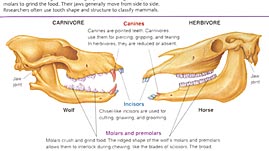Environmental conditions have shaped the evolution of every organism on the planet. From the structure of a maple tree's cells, to the camouflage of a praying mantis, to the wariness of a gazelle, countless physical and behavioral traits have grown out of the interaction between organisms and their environment. These traits, called adaptations, are the result of natural selection, and they give an organism the ability to survive and reproduce in a particular set of conditions.
One component of the environment that has been particularly influential in the evolutionary process is food. Over millions of years, the amount and type of food available to a species has dramatically influenced both the manner in which individuals of that species find food and the physical traits that help them catch and eat their food most efficiently.
The ancestors of wolves and horses -- in fact, the ancestors of all organisms -- changed little by little, over a long period of time. Traits including slightly longer or sharper canines or larger, flatter molars were passed on to the next generation if they provided an advantage. In such a way, tiny beneficial changes over millions of years and thousands of generations can accumulate and become much bigger changes that dramatically influence the way a species eats and lives.

 Loading Standards
Loading Standards Teachers' Domain is proud to be a Pathways portal to the National Science Digital Library.
Teachers' Domain is proud to be a Pathways portal to the National Science Digital Library.
